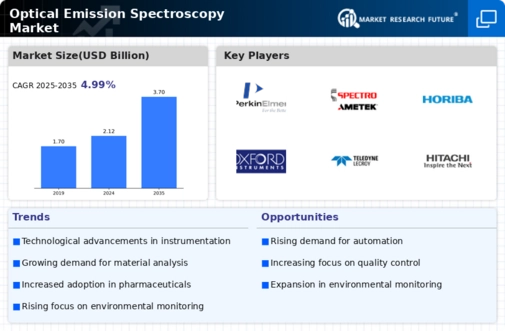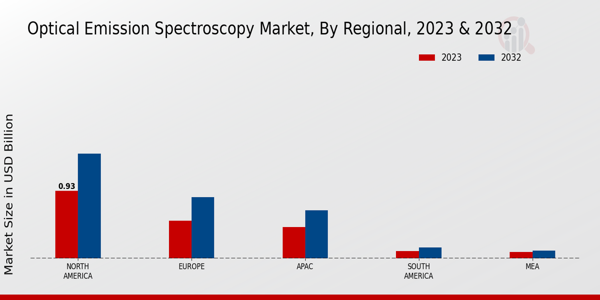Market Growth Projections
The Global Optical Emission Spectroscopy Market Industry is projected to experience substantial growth in the coming years. With a market value of 2.12 USD Billion in 2024, it is anticipated to reach 3.7 USD Billion by 2035, reflecting a robust compound annual growth rate of 5.2% from 2025 to 2035. This growth trajectory is driven by various factors, including technological advancements, increasing applications in diverse industries, and heightened regulatory requirements. The market's expansion signifies the growing importance of optical emission spectroscopy in analytical chemistry and material science, positioning it as a critical tool for future innovations.
Technological Advancements
The Global Optical Emission Spectroscopy Market Industry is experiencing rapid technological advancements that enhance the capabilities and applications of spectroscopy. Innovations in detector technology, such as the development of high-resolution CCD detectors, improve sensitivity and accuracy. This evolution allows for more precise elemental analysis in various sectors, including metallurgy and environmental monitoring. As a result, the market is projected to reach 2.12 USD Billion in 2024, driven by the increasing demand for advanced analytical techniques. The integration of automation and artificial intelligence in spectroscopic systems further streamlines workflows, making them more efficient and user-friendly.
Growth in Semiconductor Industry
The Global Optical Emission Spectroscopy Market Industry is benefiting from the growth in the semiconductor industry, where precise elemental analysis is critical for manufacturing processes. As semiconductor devices become more complex, the need for accurate characterization of materials increases. Optical emission spectroscopy provides essential insights into the composition of semiconductor materials, ensuring quality control and performance optimization. The market is poised for growth as the semiconductor sector expands, driven by innovations in technology and increasing demand for electronic devices. This trend highlights the role of optical emission spectroscopy in supporting advancements in semiconductor manufacturing.
Rising Demand in Environmental Monitoring
The Global Optical Emission Spectroscopy Market Industry is witnessing a surge in demand due to the growing emphasis on environmental monitoring and compliance. Governments worldwide are implementing stringent regulations to monitor pollutants and ensure environmental safety. Optical emission spectroscopy serves as a vital tool for analyzing trace elements in air, water, and soil samples. This trend is likely to contribute to the market's growth, with projections indicating an increase to 3.7 USD Billion by 2035. The ability of optical emission spectroscopy to provide rapid and accurate results positions it as a preferred choice for environmental agencies and industries aiming to meet regulatory standards.
Expanding Applications in Material Science
The Global Optical Emission Spectroscopy Market Industry is expanding its applications in material science, particularly in the analysis of metals and alloys. The ability to determine the composition and quality of materials is crucial for industries such as aerospace, automotive, and electronics. As manufacturers seek to enhance product quality and performance, optical emission spectroscopy becomes an indispensable tool. The market's growth is supported by a projected compound annual growth rate of 5.2% from 2025 to 2035, reflecting the increasing reliance on precise material characterization. This trend underscores the importance of optical emission spectroscopy in ensuring the integrity and reliability of advanced materials.
Increased Investment in Research and Development
The Global Optical Emission Spectroscopy Market Industry is experiencing increased investment in research and development across various sectors. Academic institutions and private companies are allocating resources to explore new applications and improve existing spectroscopic techniques. This focus on R&D is likely to drive innovation, leading to enhanced performance and new functionalities in optical emission spectroscopy systems. As a result, the market is expected to benefit from the introduction of cutting-edge technologies that cater to diverse analytical needs. The commitment to advancing spectroscopy research indicates a promising future for the industry, fostering growth and expansion.






















